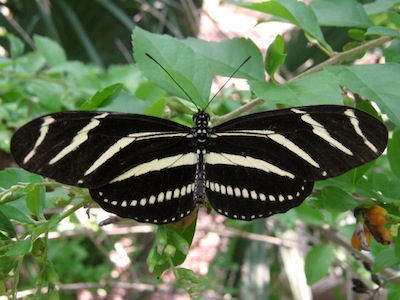H. charithonia is now rare at La Selva, even in second growth and semi-developed habitats when it might be expected to be common. It can occasionally be found in the lab clearing Passiflora garden. It has also beenseen in the forest near the arboretum. The larvae are distinctive, with a white head capsule and black spots along the back. The primary (and only?) host plant at La Selva is P. lobata. The leaves, stems and petioles of this plant are covered in tiny hooked trichomes (hairs), very much like tiny velcro hooks. The hooks catch on the integument (skin) of Heliconius larvae, tearing them open or immobilizing them. Among Heliconius, only charithonia can circumvent this defense. H. charithonia often lay 10-20 eggs together on the new growth of the plant. Feeding trials show that charithonia larvae can eat a wide range of Decaloba species, very much like H. erato. North of the range of other Heliconius, charithonia uses P. lutea and other Passiflora species as host. Range: entire neotropics north into southern USA.
Like charithonia, the Red-white Ptocadica flea beetle is adapted to survive on the hooked trichomes of P. lobata. Red Pedilia, the one other species of flea beetle I was able to test, died on the hooks when forced to eat lobata foliage.
